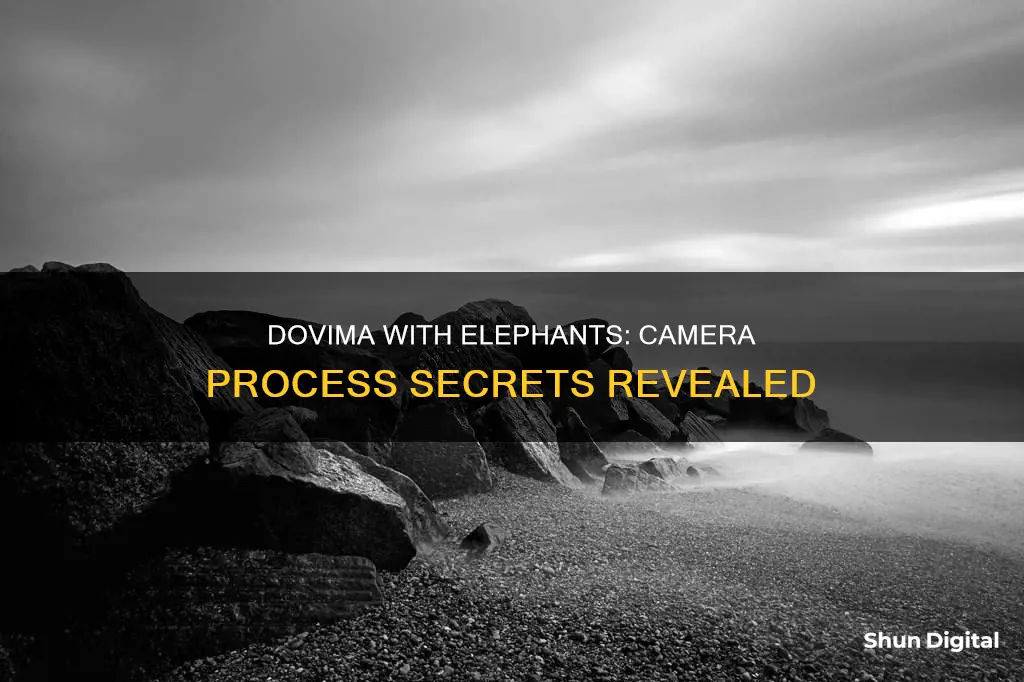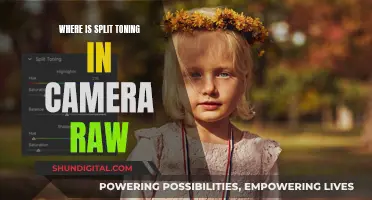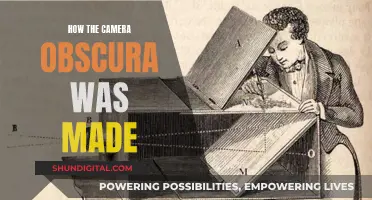
Richard Avedon's photograph 'Dovima with Elephants' was taken in Paris in 1955. It features the model Dovima posing with outstretched arms, dressed in an evening dress designed by Dior, while live elephants stand next to her. Avedon chose to place the elephants next to Dovima to convey the contrasting ages between the elephants and the model. The elephants appear tired and wrinkled, whereas Dovima appears young and beautiful. Her arms stretch towards the elephants, conveying energy and freedom, which also creates a contrast with the chained elephant's feet. Avedon used a shallow depth of field, making sure that Dovima was completely in focus, while the elephant's feet were out of focus due to their movement. This adds to the dream-like feel of the photograph.
| Characteristics | Values |
|---|---|
| Photographer | Richard Avedon |
| Model | Dovima |
| Location | Cirque d'Hiver, Paris |
| Date | August 1955 |
| Publication | Harper's Bazaar |
| Dress | Christian Dior |
| Dress Designer | Yves Saint Laurent |
What You'll Learn

The camera used to take the photo
Richard Avedon took the photograph Dovima with Elephants on an 8x10 full-frame camera. Avedon was a prolific American fashion and portrait photographer, known for his ability to capture tension and movement within his still images. He was born in New York City in 1923, and his interest in photography began in childhood when he joined a camera club at the age of 12.
Avedon's primary freelance client was Harper's Bazaar, but the publication did not provide him with studio space. This encouraged him to experiment with then-unconventional locations for shooting, such as beaches, nightclubs, and city streets. This gave his work a reputation for innovation and originality.
Avedon took the photograph Dovima with Elephants in August 1955 in Paris. He was on assignment for Harper's Bazaar editor-in-chief Carmel Snow to photograph the fall fashion collections. At the same time, film director Carol Reed was shooting the film Trapeze at the Cirque d'Hiver. Avedon saw the circus elephants and immediately chose the location for his shoot. He later said, "I saw the elephants under an enormous skylight and in a second I knew that I then had to find the right dress, and I knew that there was the potential here for a kind of dream image."
Avedon used a shallow depth of field to ensure that Dovima was completely in focus. Although the elephants' faces and trunks were in focus, their feet were out of focus due to the animals' movement. This added to the dream-like feel of the photograph, as the elephants appeared to drift away from the viewer. It also brought more attention to Dovima, who was the main subject of the photograph.
Finding the Battery on Your Fujifilm Waterproof Camera
You may want to see also

The film used
Richard Avedon's photograph "Dovima with Elephants" was taken in Paris in August 1955. The camera used for the shoot was an 8x10 full-frame camera.
Avedon was known for his ability to capture tension and movement within his still images. He was also known for his use of unconventional locations for shooting, such as beaches, nightclubs, and city streets. This gave his work a reputation for innovation and originality.
For the "Dovima with Elephants" shoot, Avedon chose the location first and then selected the dress that would work with the image he had in mind. The location was a movie set for the film "Trapeze", and Avedon loved the skylight. The dress was the first evening dress designed for Christian Dior by his new assistant, Yves Saint-Laurent.
Avedon used a shallow depth of field, making sure that Dovima was completely in focus. Although the elephants' faces and trunks were in focus, their feet were out of focus due to the animals moving. This adds to the dream-like feel of the photograph, as it almost appears as though the elephants are drifting away. It also brings more attention to the model, as Dovima appears clearer and more in focus, making her the main subject of the photograph.
Shipping Camera with Battery: Europe-Specific Guide
You may want to see also

The lighting and exposure
Richard Avedon's iconic photograph 'Dovima with Elephants' was taken in August 1955 in Paris as a part of a fashion shoot to showcase the newest pieces of Christian Dior's fashion collection. The photograph was taken in a circus, under an enormous skylight.
Avedon was one of the most famous fashion photographers and he was famed for his ability to capture tension and movement within his still images. He was selective in his photography process and used one of America's highest-paid models, Dovima, for this shoot.
Avedon wanted to bring his models out of the studio and believed that the clothing didn't just make the man but the man made the clothing. He wanted to capture movement and emotion in his photographs.
Avedon chose to place the elephants next to Dovima to convey the contrasting ages between them. The elephants appear tired and wrinkled whereas Dovima appears young and beautiful. Her arms stretch towards the elephants, conveying energy and freedom, which also creates a contrast with the chained elephant's feet.
Avedon used a shallow depth of field, making sure that Dovima was completely in focus. Although the elephants' faces and trunks were in focus, their feet were out of focus due to their movement. This adds to the dream-like feel of the photograph, as it almost appears as though the elephants are drifting away. It also brings more attention to the model, as Dovima appears clearer and is, therefore, easier to look at.
There are a lot of details within the photograph, like the straw on the elephant's feet and the wrinkles on their skin. Dovima's shadow is also clear, stretching along the floor, showing her to be a strong and powerful character and a clear figure in the photograph, adding to the energy and class she has in the photograph.
Extend Tasco Trail Camera Battery Life
You may want to see also

The location
Richard Avedon's photograph 'Dovima with Elephants' was taken at the Cirque d'Hiver in Paris, France, in August 1955. The shoot took place on the set of the film 'Trapeze', which was being directed by Carol Reed at the circus.
Avedon was in Paris on assignment for Harper's Bazaar editor-in-chief Carmel Snow to photograph the fall fashion collections. When he saw the circus elephants, he immediately chose the location for his shoot, saying:
> I saw the elephants under an enormous skylight and in a second I knew that I then had to find the right dress, and I knew that there was the potential here for a kind of dream image.
The photograph was published in the September 1955 issue of Harper's Bazaar.
Editing Raw Camera Files: A Step-by-Step Guide
You may want to see also

The model
Dovima, born Dorothy Virginia Margaret Juba, was the model for whom the term 'supermodel' was coined. She was born in Queens, New York, the daughter of a Polish-American policeman and his Irish-born wife. As a child, she contracted rheumatic fever and was bedridden for seven years. She often painted and would sign her pictures with a nom de plume that would become her modelling name: Dovima, the first two letters of her three given names.
Dovima was discovered on Lexington Avenue by a fashion editor and thrown into a photoshoot that very afternoon. The next day she was booked with Irving Penn. The story goes that he asked her to smile, which she did slyly, her mouth closed to hide a tooth she had chipped as a child. It was a haughty smile that was compared to the smirk of the Mona Lisa, and it would become the template of high fashion for the 1950s.
Dovima worked with nearly every major fashion house, from Dior to Balenciaga, and she was featured on the covers of Harper's Bazaar and Vogue more than a dozen times collectively, as well as other high-profile magazines. At her height, she commanded $60 an hour—compared to the average top rate of $25 an hour—earning her a second moniker: the Dollar-a-Minute Girl. She was one of photographer Richard Avedon's favourite models, and he considered her "the most remarkable and unconventional beauty of her time". Dovima was equally enthusiastic about the photographer: "We became like mental Siamese twins, with me knowing what he wanted before he explained it. He asked me to do extraordinary things, but I always knew I was going to be part of a great picture."
Dovima's success did not last, however, and she faced career hardship beginning in the 1960s before she left New York City in the 1970s to live with her parents in Florida, even taking work as a hostess in a local pizza parlour, before dying in relative obscurity in 1990.
Softening Skin Tones in Camera Raw: A Guide
You may want to see also
Frequently asked questions
Richard Avedon used an 8x10 full-frame camera to take the photograph.
Richard Avedon was known for his ability to capture tension and movement within his still images. He rejected traditional poses and instead pictured models in motion and using expressive gestures.
Avedon used lighting to draw attention to the difference between the white sash tied around the dress and the black dress itself. He also used lighting to highlight the difference between Dovima's pale skin and the black dress, drawing attention to her beauty and youthful appearance.







